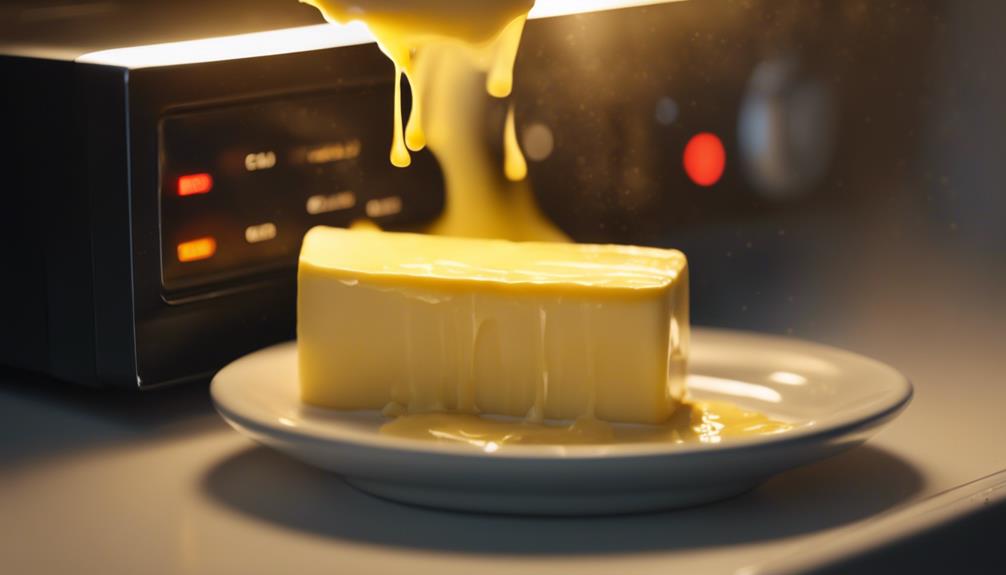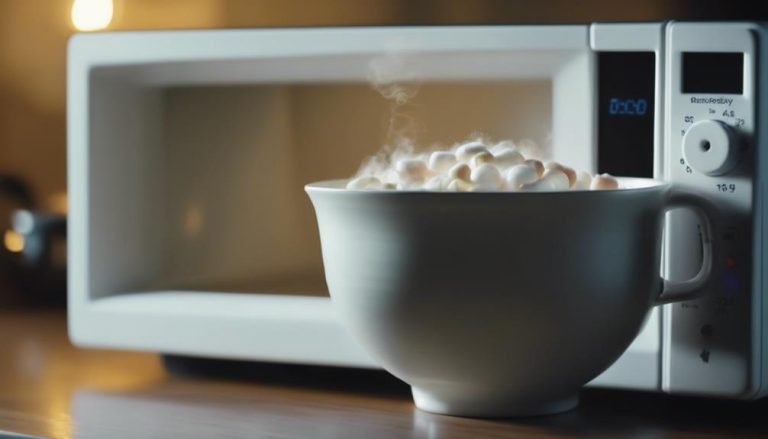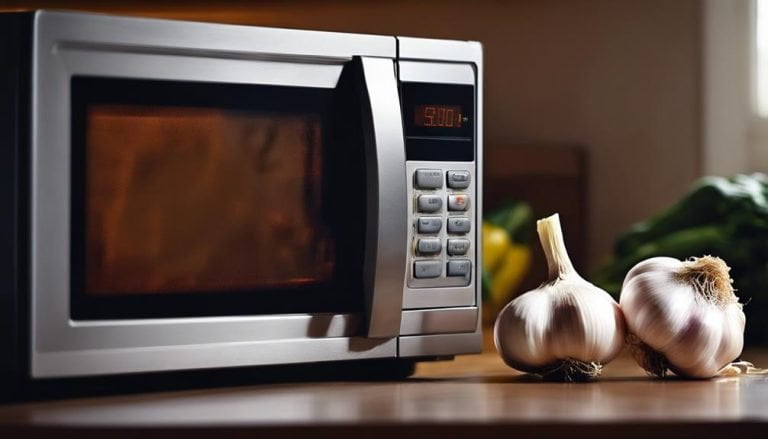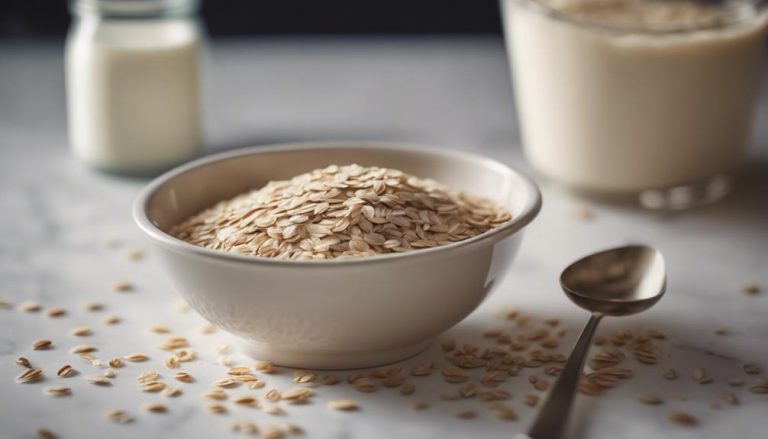Can You Microwave Butter
Yes, you can microwave butter to soften it. However, it is crucial to exercise caution to prevent the butter from melting.
To achieve the desired softness without turning it into a melty mess, it is recommended to microwave the butter in short bursts of 5-10 seconds at a time, checking its consistency after each interval. This method allows for more control over the softening process and helps avoid accidentally melting the butter.
Remember to remove any foil or packaging before microwaving and keep a close eye on the butter to ensure it reaches the desired softness without crossing the threshold into a liquid state.
Key Takeaways
- Microwave butter in short intervals to prevent uneven softening and maintain control.
- Use low power settings and stir frequently to avoid altering flavor and texture.
- Check consistency after each burst to ensure desired softness without melting.
- Avoid packaging, monitor closely, and adjust for recipes to preserve butter quality.
Safety of Microwaving Butter
When microwaving butter, caution must be exercised to prevent uneven softening and potential alterations to its structure. To soften butter quickly for baking, cut the desired amount into small pieces or slices. Place the butter in a microwave-safe cup or bowl, ensuring there is enough room for expansion.
Microwave the butter in short intervals at a low power setting, checking and stirring it frequently to avoid overheating. Softening butter without melting it entirely can be achieved by letting it rest at room temperature, but for quicker results, the microwave method can be convenient.
Careful monitoring is essential to avoid creating a mess or altering the butter's texture inadvertently, especially when using sticks of butter.
Altering Butter's Taste and Texture
Microwaving butter has the potential to alter its taste and texture due to the risk of overheating and changing its composition.
Overheated butter may develop a cooked or burnt flavor that can affect the final taste of baked goods.
It is crucial to carefully control the microwaving process to avoid uneven softening and ensure consistent results in recipes requiring softened butter.
Microwave Butter Risks
Altering the taste and texture of butter can pose significant risks when utilizing a microwave for softening purposes. Microwaving butter can lead to uneven softening and melted spots, making it challenging to control the softening process accurately.
Overheating butter in the microwave can alter its structure, potentially resulting in a greasy or oily consistency, which may affect the outcome of baked goods that require softened butter for creaming or mixing. The messiness and splattering associated with microwaving butter further complicate the process, increasing the likelihood of partially melted butter.
This compromised state of partially melted butter from the microwave can impact the integrity of baking recipes, emphasizing the importance of avoiding melting and ensuring precise control over softening methods.
Impact on Flavor
Butter's flavor and texture can undergo significant changes when exposed to microwave heating due to the uneven distribution of heat.
Softened butter at room temperature is commonly used in baking recipes, and individuals often turn to the microwave to soften it quickly. However, microwaving butter can lead to alterations in its texture and flavor, potentially resulting in a greasy or oily consistency and a cooked or burnt taste.
The delicate structure of butter is susceptible to being compromised in the microwave, affecting the overall quality of the end product. To mitigate these effects, it is crucial to monitor the butter closely and heat it in short intervals to prevent negative impacts on its texture and flavor.
Butter Melting Dos and Don'ts

When it comes to melting butter in the microwave, there are key dos and don'ts to keep in mind.
Using a low power setting and microwaving in short intervals can help avoid complete melting and maintain the butter's texture.
It is crucial to rotate and monitor the butter during microwaving to ensure even softening and prevent any splattering or mess.
Proper Butter Melting
To achieve optimal results when melting butter in the microwave, it is crucial to follow specific guidelines to avoid overheating and ensure a smooth consistency.
- Use low power or defrost setting: Prevents overheating.
- Heat in short increments: Avoids uneven melting.
- Rotate and stir between intervals: Promotes even softening.
- Use a microwave-safe dish: Prevents splattering.
- Check frequently for desired consistency: Avoids complete melting.
Avoid Butter Splattering
When melting butter in the microwave, ensuring the proper techniques can help avoid splattering and mess. To prevent splattering, start by using softened butter at room temperature.
It's advisable to utilize the microwave's defrost setting in short intervals rather than high power to achieve gradual heating and avoid uneven melting. Placing a microwave-safe cover or lid over the butter can further prevent splattering while softening.
Avoid overheating the butter as it can compromise its structure and make it overly runny. Opt for a microwave-safe dish to heat the butter gradually, ensuring controlled softening without causing splattering or mess.
These steps will help you melt butter efficiently while keeping your microwave clean.
Mess-Free Butter Microwaving
For a convenient and tidy way to soften butter in the microwave, consider using a microwave-safe dish and following specific time increments on the defrost setting. This method helps achieve softened butter for spreading without causing it to melt.
To successfully microwave butter without the mess, follow these steps:
- Place cold butter in a microwave-safe dish.
- Microwave the butter on the defrost setting in 5-second increments.
- Repeat the process, turning the butter each time to ensure even softening.
- Check the butter's softness after each increment to prevent overheating.
Achieving Perfect Butter Consistency

How can one ensure the ideal butter consistency for baking recipes without risking uneven softening or melting spots? Achieving perfect butter consistency is crucial for baking success.
To soften butter evenly and effectively, it is best to let it sit at room temperature for about 30-60 minutes before using it in recipes. This gradual softening process allows the butter to reach the ideal consistency without the risk of overheating or melting. By avoiding microwaving butter, you can maintain its structure and texture, ensuring that your baked goods turn out just right.
Softened butter is essential for incorporating air into batters, creating a light and fluffy texture in your final products. Mastering the art of even softening is key to achieving perfect butter consistency for your baking needs.
Tips for Microwaving Butter
To gently soften butter without melting it, consider utilizing the defrost setting on your microwave. When microwaving butter, it is essential to proceed in short increments of 5-10 seconds to prevent overheating and melting. Turn the butter occasionally during the microwaving process to ensure even softening. Avoid using high power settings as this can cause the butter to melt too quickly. Check the consistency of the butter after each microwaving interval to ensure it reaches the desired softness.
- Use the microwave on the defrost setting to gently soften butter without melting it.
- Microwave butter in short increments (5-10 seconds) to prevent overheating and melting.
- Turn the butter occasionally while microwaving for even softening.
- Avoid using high power settings to prevent butter from melting too quickly.
- Check the consistency of the butter after each microwaving interval to ensure it reaches the desired softness.
Frequently Asked Questions
Can Microwaving Butter Cause It to Explode?
Butter explosion: a reality. Microwaving butter can cause it to explode due to steam buildup. Safety concerns arise from temperature spikes. Microwave results vary in consistency. Flavor impact possible. Best practice includes using a microwave-safe container. Tips: low power settings, short increments.
Will Microwaving Butter Affect Its Nutritional Value?
Heating butter in the microwave can significantly impact its nutritional value, leading to nutrient loss and potential oxidation of fats. Careful microwave cooking, like melting butter on low power, is crucial for maintaining the integrity of butter in various recipes and dishes during food preparation.
Is It Safe to Microwave Butter in a Plastic Container?
When considering the safety of microwaving butter in a plastic container, factors such as butter temperature, plastic safety, melting potential, microwave settings, splattering risks, heating time, and butter consistency must be carefully assessed to ensure a safe and efficient butter softening process.
Can Microwaving Butter Cause It to Become Rancid?
Microwaving butter can alter its temperature, consistency, flavor, and texture. Heating beyond its melting point can lead to rancidity, affecting its shelf life and suitability for various cooking applications. Proper microwaving techniques can prevent these issues.
How Long Can I Store Microwaved Butter Before It Goes Bad?
Butter storage is crucial for maintaining freshness. After microwaving, refrigerate within 2 hours. Store microwaved butter in airtight containers labeled with the date. Avoid room temperature storage for extended periods. Freezing can extend shelf life up to 6 months.
Conclusion
In conclusion, microwaving butter can be a quick and efficient way to soften it, but caution is needed to avoid melting.
By using the Defrost setting and heating the butter in short increments, you can achieve the perfect consistency for spreading.
Remember, microwaving butter is like walking a tightrope – too much heat and it melts, too little and it remains solid.
Find the balance to enjoy perfectly softened butter every time.





